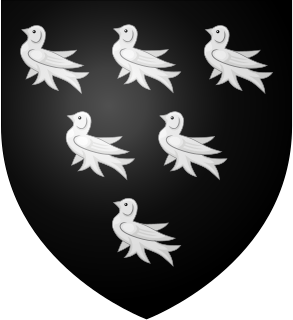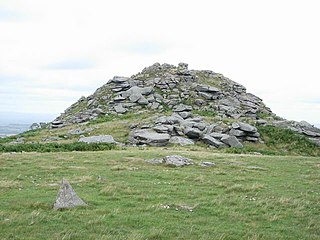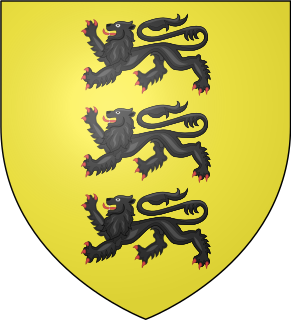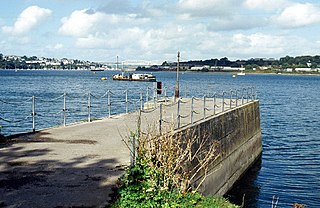
Liskeard is a small ancient stannary and market town in south-east Cornwall, South West England. It is situated approximately 20 miles (32 km) west of Plymouth, 14 miles (23 km) west of the Devon border, and 12 miles (20 km) east of Bodmin. The Bodmin Moor lies to the north-west of the town. The total population of the town at the 2011 census was 11,366

Torpoint is a civil parish and town on the Rame Peninsula in southeast Cornwall, England, United Kingdom. It is situated opposite the city of Plymouth across the Hamoaze which is the tidal estuary of the River Tamar. Torpoint had a population of 8,457 at the 2001 census, decreasing to 8,364 at the 2011 census. Two electoral wards also exist. Their combined populations at the same census were 7,717.

Saltash is a town and civil parish in south Cornwall, England, United Kingdom. It had a population of 16,184 in 2011 census. Saltash faces the city of Plymouth over the River Tamar and is popularly known as "the Gateway to Cornwall". Saltash’s landmarks include the Tamar Bridge which connects Plymouth to Cornwall by road, and the Royal Albert Bridge. The area of Latchbrook is part of the town.
Carew is a Welsh and Cornish habitation-type surname; it has also been used as a synonym for the Irish patronymic Ó Corráin. Carey can be a variant.

Callington is a civil parish and town in east Cornwall, England, United Kingdom about 7 miles (11 km) north of Saltash and 9 miles (14 km) south of Launceston.

The hundreds of Cornwall were administrative divisions or Shires (hundreds) into which Cornwall, the present day administrative county of England, in the United Kingdom, was divided between c. 925 and 1894, when they were replaced with local government districts.

St Mawgan or St Mawgan in Pydar is a village and civil parish in Cornwall, England, United Kingdom. The population of this parish at the 2011 census was 1,307. The village is situated four miles northeast of Newquay, and the parish also includes the hamlet of Mawgan Porth. The surviving manor house known as Lanherne House is an early 16th-century grade I listed building. The nearby Royal Air Force station, RAF St Mawgan, takes its name from the village and is next to Newquay Cornwall Airport. The River Menalhyl runs through St Mawgan village and the valley is known as The Vale of Lanherne. It was the subject of a poem by poet Henry Sewell Stokes.
The Rame Peninsula is a peninsula in south-east Cornwall. The peninsula is surrounded by the English Channel to the south, Plymouth Sound to the east, the Hamoaze to the northeast and the estuary of the River Lynher to the northwest. On a clear day, the Atlantic Ocean can be seen from advantageous points from Rame Head. The largest settlement is Torpoint, which is on the eastern coast, facing Devonport in Plymouth, Devon.

Trerice is an historic manor in the parish of Newlyn East, near Newquay, Cornwall, United Kingdom. The surviving Tudor manor house known as Trerice House is located at Kestle Mill, three miles east of Newquay. The house with its surrounding garden has been owned by the National Trust since 1953 and is open to the public. The house is a Grade I listed building. The two stone lions on the front lawn are separately listed, Grade II. The garden features an orchard with old varieties of fruit trees.

Gerrans is a coastal civil parish and village on the Roseland Peninsula in Cornwall, England, United Kingdom. The village adjoins Portscatho on the east side of the peninsula. The village is situated approximately seven miles (11 km) south-southeast of Truro.

Ruan Lanihorne is a civil parish and village in south Cornwall, England, United Kingdom. The village is situated approximately four miles (6.5 km) east-southeast of Truro between the River Fal and its tributary the Ruan River.

Helland is a civil parish and village in Cornwall, England, United Kingdom. It is situated 2+1⁄2 miles (4.0 km) north of Bodmin. The meaning of the name Helland is unclear: it is possible that the origin is in Cornish hen & lan. The original dedication of the church is unknown but St Helena is now recognised as the patron.

Humphrey Arundell of Helland in Cornwall, was the leader of Cornish forces in the Prayer Book Rebellion early in the reign of King Edward VI. He was executed at Tyburn, London after the rebellion had been defeated.

Linkinhorne is a civil parish and village in southeast Cornwall, England, United Kingdom. The village itself is situated at grid reference SX 320 736 and is approximately four miles (6.5 km) northwest of Callington and seven miles (11 km) south of Launceston. The parish population at the 2011 census including Downgate was 1,541

There have been three baronetcies created for persons with the surname Carew, two in the Baronetage of England prior to 1707, one in the Baronetage of Great Britain.

St Gennys is a coastal civil parish and small settlement in north Cornwall, England, United Kingdom.
St John is a coastal civil parish and a village in south-east Cornwall, England, United Kingdom, 3 miles (4.8 km) south of Saltash and 1.5 miles (2.4 km) south-west of Torpoint.

Sir Alexander Carew was an English landowner, soldier and politician from Antony, Cornwall. Elected Member of Parliament for Cornwall in November 1640, he voted for the execution of the Earl of Strafford in May 1641, and supported the removal of bishops from the Church of England.

Wilcove is a small coastal village in Cornwall, England, United Kingdom. It is situated one mile (1.6 km) north of Torpoint and one mile (1.6 km) west of Devonport across the Hamoaze, the tidal estuary of the River Tamar.

The Arundell family of Cornwall are amongst the few Cornish families of Norman origin, and there are still fewer of French extraction who have for so long a period been, like them, traceable in that county.


















